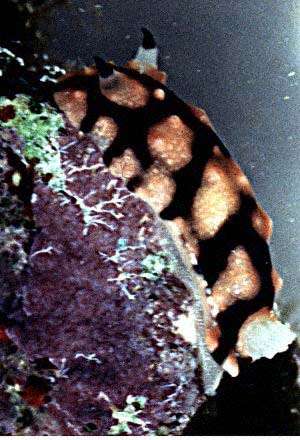
Paradoris cf. liturata
Order: NUDIBRANCHIA
Suborder: DORIDINA
Superfamily: EUDORIDOIDEA
Family: Discodorididae
PHOTO
Egypt, Red Sea, 1997. Photo: Michael Shroedl.
Note added 5 March 2007: This species was previously on the Forum as Doris? sp. 3.
This apparently unnamed dorid is another mimic of a phyllidiid. It has a resemblance to Phyllidiopis dautzenbergi, which is endemic to the Red Sea. It is possibly a form of Paradoris liturata.
See phyllidiid mimics for links to other examples of nudibranchs mimicking phyllidiids.
Authorship detailsRudman, W.B., 2007 (March 1) Paradoris cf. liturata [In] Sea Slug Forum. Australian Museum, Sydney. Available from http://www.seaslugforum.net/find/paracflitu
Related messages
Dorsal gills on Phyllidiella ?
October 14, 2009
From: Kamal El Tawil
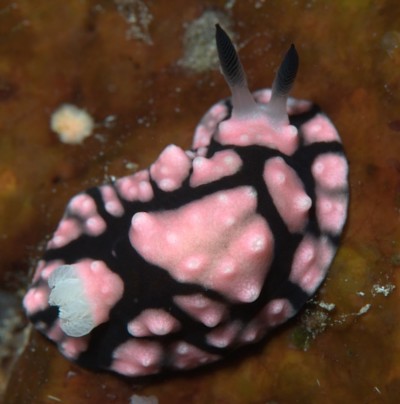
Dear Bill,
I was organizing some pictures a friend took while we were on a dive trip last July. One picture of what I first identified as either Phyllidiella annulata (pink rings) or Phyllidiella pustulosa looked a bit odd.
The animal has dorsal gills. Normally it would have its gills under its mantle. I checked the similar species on this Forum as well as other references but I couldn't find anything similar. I don't know if my identification is correct so is this a different species or do we here see an abnormality?
Locality: St. John's reef, Egypt, Red Sea, 07 July 2009, Offshore reef. Length: 20-25 mm. Photographer: Peter Geervliet.
Kindest regards,
Kamal El Tawil
www.coralworld.net
kamal@coralworld.net
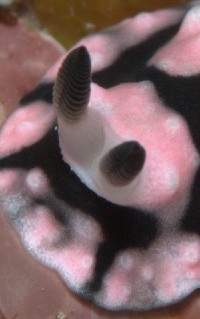
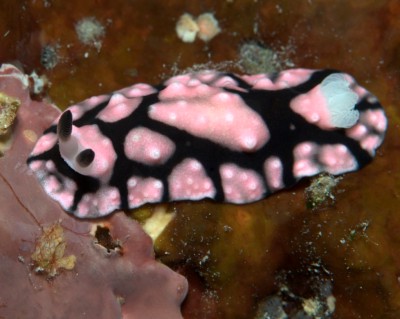
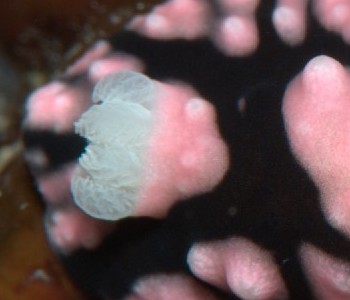
Dear Kamal,
Thes are very nice photos of a dorid which looks very like some species of Phyllidiella and Phyllidopsis, but as you have noticed, its dorsal gills suggest there is something wrong. In the western Pacific and eastern Indian Ocean there is a species which is now called Paradoris liturata. Specimens like yours, from the western Indian Ocean, look slightly different so I am calling them Paradoris cf. liturata, but they could well be the same species. They are quite unrelated to the phyllidiids but we do not know if their external similarity to that family is a coincidence or an amazing example of mimicry.
Best wishes,
Bill Rudman
Phyllidiella mimic? from Borneo
October 10, 2005
From: Sylvain Le Bris
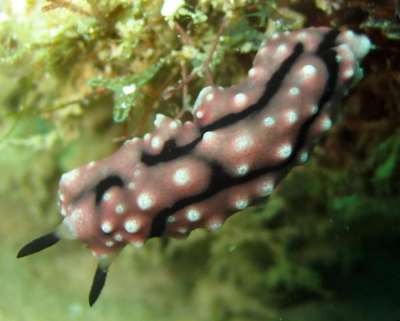
An other Phyllidiella? found in the rich water of Mabul Island.
I didn't succeed to identify it...
Locality: Mabul Island, Borneo, Malaysia. Depth: 20 m. Length: 2 cm. September 2005. Photographer: Sylvain Le Bris
Sylvain Le Bris
sylvain.lebris@freesbee.fr
Le Bris, S., 2005 (Oct 10) Phyllidiella mimic? from Borneo. [Message in] Sea Slug Forum. Australian Museum, Sydney. Available from http://www.seaslugforum.net/find/14885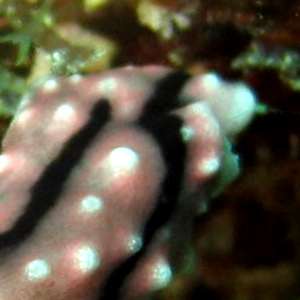
Note added 5 March 2007: This is a species of Paradoris. It was previously on the Forum as Doris? sp. 3.
Dear Sylvain,
I can't be 100% sure, but I think this is not a phyllidiid but a 'normal' dorid which mimics species of Phyllidiella. It is probably the one I am callingDoris sp. 3, but that is known only from the Red Sea at present. In the close-up alongside I think I can see the gill pocket. perhaps of you have other photos of it we could see if there is any signs of a gill pocket or gills.
Best wishes,
Bill Rudman
Phyllidia mimic from Red Sea
February 28, 2001
From: Bernard Picton
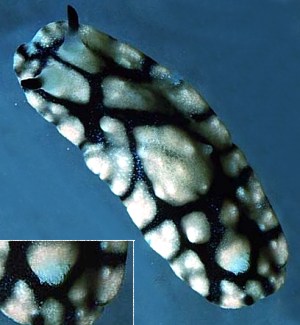
Dear Bill,
Your Phyllidiella sp 1 from Erwin Koehler is a Phyllidia mimic - I enclose a scan of an animal which I collected in the Sinai in 1980. The gills [see inset] are very inconspicuous - perhaps fish are smarter than we give them credit!
Nathalie Yonow had these specimens but I don't know if she did anything with this one.
Bernard
bernard.picton.um@nics.gov.uk
Picton, B., 2001 (Feb 28) Phyllidia mimic from Red Sea. [Message in] Sea Slug Forum. Australian Museum, Sydney. Available from http://www.seaslugforum.net/find/3761Note added 5 March 2007: This is a species of Paradoris. It was previously on the Forum as Doris? sp. 3.
Thanks Bernard,
When you can't see the gills it certainly looks like a phyllidiid. After gettng your message I had a look through the phyllidiid mimics on the Forum and realise I already have it asDoris sp. 3.
So I have amalgamated all the messages on to one page. They certainly are amazing animals and although I have no evidence, I can't help feeling that these phyllidiid look-alikes are mimicking phyllidiids to enhance their chances of survival.
Bill Rudman
Phyllidiopsis sinaiensis? from Red Sea
February 24, 2000
From: Erwin Koehler
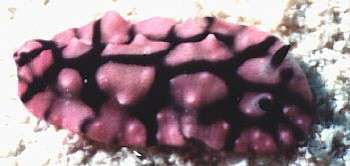
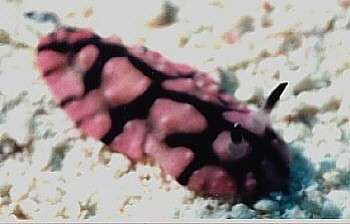
Bill,
My first idea was Phyllidiella pustulosa, then I noticed the rhinopores and that it has no pink mantle edge. Now I think it might be
Phyllidiopsis sinaiensis Yonow, 1988 - but I have no description of this one...Can you help with an ID? The quality of the photos is
rather poor, they are some of my first uw-photos. Better bad photos than no photos. They are from the Red Sea, Egypt, Safaga, divesite "Tobya Arba", 11m depth, size ~ 15 mm, May 31, 1993.
Erwin
Medslugs.Koehler@t-online.de
Koehler, E., 2000 (Feb 24) Phyllidiopsis sinaiensis? from Red Sea. [Message in] Sea Slug Forum. Australian Museum, Sydney. Available from http://www.seaslugforum.net/find/1908Note added 5 March 2007: This is a species of Paradoris. It was previously on the Forum as Doris? sp. 3.
Dear Erwin,
Your animal is a bit of puzzle. I agree it doesn't fit Phyllidiella pustulosa very well but I have my doubts about it being Phyllidiopsis sinaiensis.
Your earlier photo of Phyllidiopsis sinaiensis is almost identical to the illustration of the holotype in Nathalie Yonow's original description. One apparently characteristic feature of that species is the median ridge down the mantle. In the photos here from Egypt there is clearly no central ridge. However like P. sinaiensis this animal has simple tubercles, but it differs in having black rhinophore clubs. In P. sinaiensis the rhinophore clubs are white on the anterior face and black posteriorly.
Black rhinophores are a character of Phyllidiella but it doesn't seem to fit any species I am familiar with.
Best wishes,
Bill Rudman.
Note added 27 February 2001: This animal is a dorid mimic of Phyllidiella. See Bernard Picton's message..
A Phyllidiopsis? mimic from Red Sea
January 14, 1999
From: Michael Shroedl
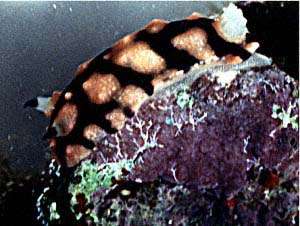
Dear Dr. Rudman,
With great interest I am following your discussion on phyllidiid mimicry. Also in Egypt, I found a chromodorid which closely resembles P. pustulosa and others. It may or may not be the specimen illustrated by Debelius (1997:210) as Chromodoris geometrica from the Philippines, but I strongly doubt the latter identification.
Many thanks for your help.
Best regards,
Michael
Muenchen
Germany
schroedl@zi.biologie.uni-muenchen.de
Shroedl, M., 1999 (Jan 14) A Phyllidiopsis? mimic from Red Sea. [Message in] Sea Slug Forum. Australian Museum, Sydney. Available from http://www.seaslugforum.net/find/466Note added 5 March 2007: This is a species of Paradoris. It was previously on the Forum as Doris? sp. 3.
Dear Michael,
Another spectacular animal! I have been conservative in calling it Doris?. When you say it is a chromodorid do you mean you have looked at its anatomy? If so I'll put it in the appropriate genera when you let me know.
You are correct in doubting that it is Chromodoris geometrica. The granular appearance of its mantle looks quite unlike a tropical chromodorid.
Thanks for sharing it with us. I wonder how many more phyllidiid mimics we will end up with.
Best wishes,
Bill Rudman.
